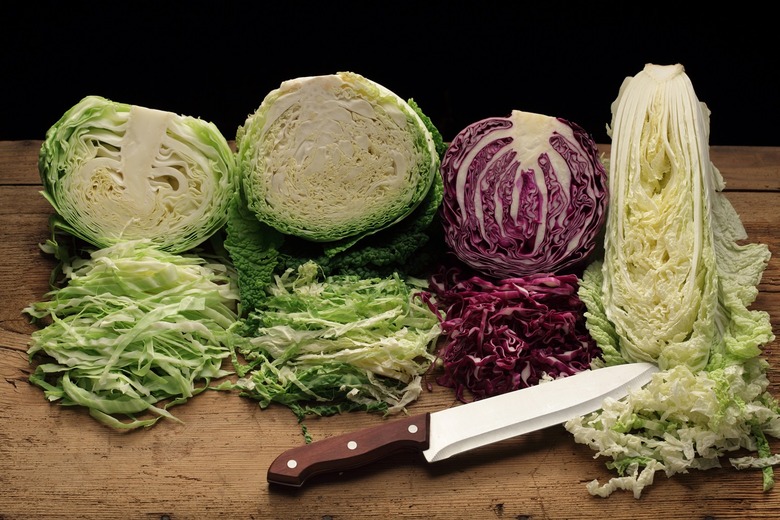Ingredient Spotlight: Cabbage (And 8 Cabbage Recipes)
Cabbage doesn't necessarily have the best rep in the food world. This leafy vegetable may be pungent when cooked or fermented or may call to mind those bitter red bits sprinkled into your bagged salad mix from the grocery store. Economical and nutritious as it is, cabbage can be something of an afterthought. But, like Brussels sprouts before it, it's time that cabbage gets its moment in the spotlight.
Different kinds of cabbage
Though different types of cabbage can be used interchangeably in some recipes, the first step in your cabbage education should be learning to tell them apart. A member of the Brassica family — along with fan favorites like Brussels sprouts, cauliflower and broccoli — there's more to cabbage than red and green.
Green cabbage
When you think of "cabbage," odds are you're picturing good ol' green cabbage. With thick leaves and a slight waxy texture, green cabbage has a crisp, sweet and slightly grassy flavor. This is the type of cabbage you see most commonly in coleslaw.
Red cabbage
Though called red cabbage, this veggie really is more of a purple or burgundy than bright tomato red. It's chewier and coarser than other cabbage varieties and has a bolder, more peppery flavor that can be a bit bitter. Red cabbage is often incorporated into slaws and is also excellent pickled, roasted and grilled.
Savoy cabbage
Like green cabbage, savoy cabbage is green, large and dense, but its super crinkly leaves make it distinctive. The outer leaves are tough and crunchy while the inner leaves are tender and crisp. The flavor throughout is mild, earthy and sweet. This is widely considered to be the most versatile cabbage and works in Asian- or European-styled preparations. Savoy cabbage is usually the top choice for stuffed cabbage recipes.
Napa cabbage
Napa cabbage is more of a cylinder compared to the previous circular cabbages, with a wrinkled appearance. The outer leaves are dark green, but the leaves at the center are quite light, with a rib that has a crunchy texture and mildly sweet crisp flavor. Napa cabbage is the go-to for making kimchi.
Bok choy
Bok choy is quite distinctive looking with thick white stems and tender leafy tops. The white is crunchy while the green tops are soft, and when raw, it's sweet with a slight mustardy flavor. When cooked, the whole bok choy becomes tender and slightly earthy. Bok choy is particularly well suited to sauteing, adding to soups and as a filling for dumplings.
Health benefits of eating cabbage
For being about 92% water, cabbage is ridiculously nutritious. A serving of cabbage boasts loads of calcium, potassium, phosphorus and vitamin C, plus a decent amount of vitamin K. These properties help to boost your immune system and brain health. The high fiber and water contents make this one of the best foods for digestion and fighting inflammation.
What to do with cabbage
Cabbage is a versatile vegetable and can be used basically any way you want: simmered in soups and stews, stir-fried with other veggies and protein, chopped up fine and served as a slaw or salad or grilled, braised, steamed, sauteed, roasted or even juiced. Thick, firm cabbage leaves can also be used as a wrap for hearty fillings. Need some ideas for cabbages? Here are a few of our favorite cabbage recipes:
Coleslaw
Perhaps one of the best-known American applications for cabbage, coleslaw is a crunchy, refreshing side that pairs perfectly with hearty grilled food like burgers, sausages and dark meat chicken. Coleslaw can have mayonnaise or vinegar based dressings; this particular recipe uses rice vinegar to balance out the sweetness of the cabbage.
For the Coleslaw recipe, click here.
Fried Cabbage
This easy fried cabbage recipe uses just cabbage, onions, oil and seasonings, which allows the vegetable to shine in its cooked form. This versatile side will go with pretty much whatever you want. If you want to serve this as more of a main course or punch it up, follow a similar recipe that adds bacon and diced onions.
For the Fried Cabbage recipe, click here.
Wonton Soup
This wonton soup uses baby bok choy in the broth, which adds a nice earthy note to this hearty Chinese soup. If you want to use your cabbages two ways in this recipe, swap the scallions in the wontons for the white part of your bok choy.
For the Wonton Soup recipe, click here.
Cabbage Rolls
Cabbage leaves can be a great vessel for stuffing things, like this comforting mixture of beef and rice. Even better for cabbage lovers? This recipe uses the veggie two ways: as a wrap and in the sauce.
For the Cabbage Rolls recipe, click here.
Kimchi Slaw
If you want all of the spicy flavors of Korean kimchi but you don't have days and days to let it ferment, this easy napa cabbage slaw is a great go-to.
For the Kimchi Slaw recipe, click here.
Cabbage Soup
Cabbage soup has a bad rap as a stinky soup used for rapid weight loss. But, with a few variations on that classic recipe, you can actually enjoy cabbage soup for its flavor. Pair it with a nice sandwich for a complete, satisfying meal.
For the Cabbage Soup recipe, click here.
Braised Red Cabbage
Red cabbage works very well for braising, due to its relatively tough, waxy texture. When mixed with smoked pork, red wine, sherry vinegar and brown sugar, you get a perfectly tart yet sweet side that will go great with roasted meats.
For the Braised Red Cabbage recipe, click here.
Corned Beef and Cabbage
Perhaps one of the best-known ways to cook with cabbage, corned beef and cabbage is a St. Patrick's Day staple, but honestly, it tastes good any day of the year.
For the Corned Beef and Cabbage recipe, click here.
.
